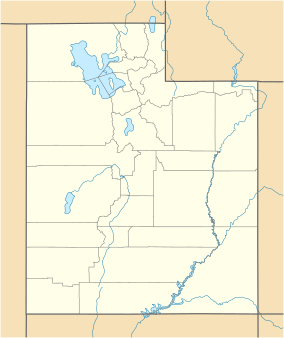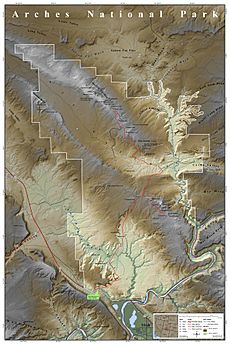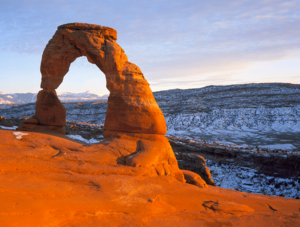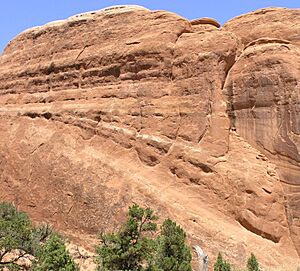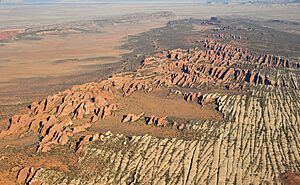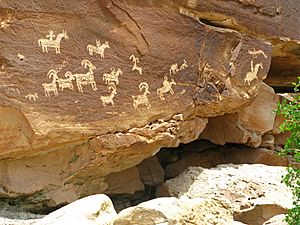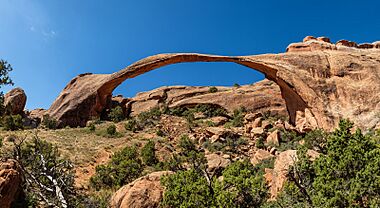Arches National Park facts for kids
Quick facts for kids Arches National Park |
|
|---|---|
|
IUCN Category II (National Park)
|
|

Delicate Arch with background of La Sal Mountains
|
|
| Location | Grand County, Utah, US |
| Nearest city | Moab, Utah |
| Area | 76,679 acres (119.811 sq mi; 31,031 ha; 310.31 km2) |
| Established | April 12, 1929, as a national monument |
| Visitors | 1,460,652 (in 2022) |
| Governing body | National Park Service |
Arches National Park is a special place in eastern Utah, United States. It's next to the Colorado River, about 4 miles (6.4 km) north of Moab, Utah. This park is famous for having more than 2,000 amazing natural sandstone arches. It has the most natural arches anywhere in the world! One of the most famous is Delicate Arch.
The park also has many other cool rock shapes. These include tall spires, balanced rocks, and long sandstone walls called fins. All these amazing formations are here because of a thick layer of salt deep underground. This salt layer helps create the unique landscape.
Arches National Park covers about 120 square miles (310.31 km2) of high desert. It's part of the Colorado Plateau. The highest point is Elephant Butte, which is 5,653 feet (1,723 m) high. The lowest point is 4,085 feet (1,245 m) at the visitor center. The park doesn't get much rain, usually less than 10 inches (250 mm) each year.
The National Park Service takes care of Arches. It first became a national monument on April 12, 1929. Later, on November 12, 1971, it was made a national park. In 2021, over 1.8 million people visited the park. If you want to visit between April 1 and October 31, you need to book a timed entry ticket. This helps manage the number of visitors.
Contents
Geology: How Arches Formed
Arches National Park sits on top of a huge underground salt bed. This salt bed is thousands of feet thick in some places. It formed about 300 million years ago when a sea covered this area and then dried up. Over millions of years, dirt and rocks piled up on top of the salt.
Later, around 200 million years ago, this area became a desert. Huge sand dunes formed, which eventually turned into a rock layer called Navajo Sandstone. Then, about 140 million years ago, more sand and dirt created another rock layer called Entrada Sandstone. Most of the famous arches you see today are made from this Entrada Sandstone.
The heavy weight of all these rock layers pushed down on the salt bed. This made the salt move and create big domes and long ridges underground. This movement also caused cracks and faults in the rock layers above. One big crack, the Moab Fault, can be seen from the visitor center.
As the salt moved and the land shifted, erosion slowly wore away the younger rock layers. What we see today are mostly the salmon-colored Entrada Sandstone and the buff-colored Navajo Sandstone. These layers are stacked like a cake.
Over time, water got into the cracks and folds of these rock layers. When water froze, it expanded and pushed on the rock, breaking off small pieces. Wind then blew away the loose bits. This left behind tall, thin walls of rock called fins. Wind and water kept attacking these fins. Eventually, in some places, the rock holding the fins together broke down. Chunks of rock fell out, creating openings. Some fins collapsed, but others with the right strength and balance survived. These became the famous arches!
Even though the park looks tough, it's actually very fragile. Over a million visitors each year can harm the delicate desert environment. The soil has a special crust made of tiny living things like bacteria, algae, and fungi. This crust helps hold the soil together and absorb water. Walking off trails can easily break this crust, making the soil more likely to erode and harder for plants to grow. Park rangers work hard to protect this special soil.
How Arches Formed: A Closer Look
The process of arch formation started over 300 million years ago. That's when a huge salt bed was laid down deep underground. This salt bed is still there, beneath Arches National Park. Over time, layers of sediment piled up on top of the salt. These sediments eventually hardened into rock, forming the Entrada Sandstone.
As the salt bed shifted and moved, it pushed up the rock layers above it. This caused long, vertical cracks to form. These cracks eventually became tall, thin walls of rock called fins. Sand would collect between these fins. When rain fell, it mixed with carbon dioxide in the air. This created a weak acid called carbonic acid. This acid slowly dissolved the natural glue (calcium carbonate) that held the sandstone together.
Many rock formations have weaker layers of rock at the bottom. These weaker layers dissolved first, creating openings. Then, gravity caused pieces of the stronger rock above to fall away. This created the arch shape. Arches usually form where the rock has weak spots or many cracks.
Finally, water, wind, and time continued to erode the rock. This process shaped the arches into the amazing forms we see today. All the arches in the park are made of Entrada Sandstone. However, each arch formed a little differently. Some arches are tall and thin, while others are wide and flat. The erosion process is still happening. Some arches will eventually collapse, but new ones will also continue to form for thousands of years.
Climate
Arches National Park has a cold semi-arid climate. This means it's generally dry with hot summers and cold winters.
| Climate data for Arches National Park Headquarters, Utah, 1991-2020 normals, extremes 1980-present | |||||||||||||
|---|---|---|---|---|---|---|---|---|---|---|---|---|---|
| Month | Jan | Feb | Mar | Apr | May | Jun | Jul | Aug | Sep | Oct | Nov | Dec | Year |
| Record high °F (°C) | 63 (17) |
74 (23) |
87 (31) |
93 (34) |
105 (41) |
110 (43) |
116 (47) |
109 (43) |
105 (41) |
95 (35) |
79 (26) |
69 (21) |
116 (47) |
| Mean maximum °F (°C) | 54.8 (12.7) |
64.6 (18.1) |
77.2 (25.1) |
85.8 (29.9) |
95.0 (35.0) |
104.2 (40.1) |
107.3 (41.8) |
104.2 (40.1) |
99.0 (37.2) |
88.5 (31.4) |
70.7 (21.5) |
56.4 (13.6) |
108.0 (42.2) |
| Mean daily maximum °F (°C) | 41.5 (5.3) |
50.0 (10.0) |
62.1 (16.7) |
69.6 (20.9) |
80.1 (26.7) |
92.5 (33.6) |
98.7 (37.1) |
95.8 (35.4) |
87.1 (30.6) |
72.1 (22.3) |
55.9 (13.3) |
41.9 (5.5) |
70.6 (21.4) |
| Daily mean °F (°C) | 31.9 (−0.1) |
39.6 (4.2) |
49.5 (9.7) |
56.7 (13.7) |
66.6 (19.2) |
77.8 (25.4) |
84.5 (29.2) |
81.9 (27.7) |
72.7 (22.6) |
58.1 (14.5) |
44.3 (6.8) |
32.9 (0.5) |
58.0 (14.4) |
| Mean daily minimum °F (°C) | 22.3 (−5.4) |
29.1 (−1.6) |
36.9 (2.7) |
43.7 (6.5) |
53.0 (11.7) |
63.0 (17.2) |
70.3 (21.3) |
67.9 (19.9) |
58.3 (14.6) |
44.2 (6.8) |
32.6 (0.3) |
23.9 (−4.5) |
45.4 (7.4) |
| Mean minimum °F (°C) | 10.7 (−11.8) |
16.8 (−8.4) |
24.8 (−4.0) |
30.6 (−0.8) |
39.1 (3.9) |
49.1 (9.5) |
58.2 (14.6) |
57.8 (14.3) |
43.1 (6.2) |
29.1 (−1.6) |
18.8 (−7.3) |
10.7 (−11.8) |
7.4 (−13.7) |
| Record low °F (°C) | −4 (−20) |
−8 (−22) |
13 (−11) |
21 (−6) |
28 (−2) |
37 (3) |
50 (10) |
44 (7) |
26 (−3) |
16 (−9) |
10 (−12) |
−4 (−20) |
−8 (−22) |
| Average precipitation inches (mm) | 0.55 (14) |
0.56 (14) |
0.65 (17) |
0.71 (18) |
0.75 (19) |
0.43 (11) |
0.73 (19) |
0.90 (23) |
0.88 (22) |
1.12 (28) |
0.56 (14) |
0.61 (15) |
8.45 (215) |
| Average snowfall inches (cm) | 2.1 (5.3) |
1.2 (3.0) |
0.5 (1.3) |
0.0 (0.0) |
0.0 (0.0) |
0.0 (0.0) |
0.0 (0.0) |
0.0 (0.0) |
0.0 (0.0) |
0.1 (0.25) |
0.7 (1.8) |
3.5 (8.9) |
8.1 (21) |
| Average precipitation days (≥ 0.01 in) | 4.2 | 4.5 | 4.9 | 5.0 | 4.8 | 2.4 | 4.7 | 6.0 | 4.9 | 5.5 | 4.1 | 3.8 | 54.8 |
| Average snowy days (≥ 0.1 in) | 1.5 | 0.9 | 0.3 | 0.0 | 0.0 | 0.0 | 0.0 | 0.0 | 0.0 | 0.1 | 0.4 | 2.1 | 5.3 |
| Source: NOAA | |||||||||||||
| Mean daily daylight hours for Arches National Park | |||||||||||||
|---|---|---|---|---|---|---|---|---|---|---|---|---|---|
| Month | Jan | Feb | Mar | Apr | May | Jun | Jul | Aug | Sep | Oct | Nov | Dec | Year |
| Mean daily daylight hours | 10.0 | 10.5 | 12.0 | 13.0 | 14.0 | 15.0 | 14.5 | 13.5 | 12.5 | 11.5 | 10.0 | 9.5 | 12.2 |
| Source: Weather Atlas | |||||||||||||
History of Arches National Park
People have lived in the Arches area for a very long time. The first humans arrived about 10,000 years ago, after the last ice age. The Fremont people and Ancestral Puebloans lived here until about 700 years ago.
In 1775, Spanish missionaries met Ute and Paiute tribes in the area. Later, in the 1870s, ranchers and farmers settled nearby in Moab. People started to hear about the amazing rock formations. They thought it could be a great place for tourists to visit.
In 1923, a railroad manager named Frank A. Wadleigh visited the area. He was invited by Alexander Ringhoffer, a prospector who had discovered a beautiful spot he called Devils Garden. Wadleigh was very impressed. He suggested to the National Park Service that the area should become a national monument.
After more studies, President Herbert Hoover officially created Arches National Monument on April 12, 1929. The main goal was to protect the unique arches, spires, and balanced rocks. In 1938, President Franklin D. Roosevelt made the monument bigger to protect more beautiful areas.
Later, in 1971, President Richard Nixon signed a law that changed Arches National Monument into Arches National Park. It was officially dedicated in May 1972.
Sometimes, people have tried to damage the ancient rock carvings (called petroglyphs) in the park. But park officials have used special technology, like lasers, to repair the damage and protect these important historical sites.
Fun Activities at Arches National Park
Arches National Park offers many exciting things to do!
- Auto Touring: You can drive along the scenic roads and stop at viewpoints to see the arches.
- Hiking: There are many trails for all skill levels. You can hike to famous arches like Delicate Arch or explore other areas.
- Bicycling: You can ride bikes on the paved roads.
- Camping: The Devils Garden campground is a great place to stay overnight.
- Backpacking, Canyoneering, and Rock Climbing: For more adventurous activities, you need special permits.
- Ranger Programs: Park rangers lead tours and talks to teach you about the park.
- Stargazing: The park has very dark skies, making it a wonderful place to see stars and planets.
To protect the arches, climbing on Balanced Rock or any named or unnamed arch with an opening larger than 3 feet (0.91 m) is not allowed. This rule helps keep these natural wonders safe for everyone.
Arches in Pop Culture
Delicate Arch is so famous that it was featured on the back of the 2014 Utah quarter! It's a symbol of the state.
A famous American writer named Edward Abbey worked as a park ranger at Arches in the 1950s. He wrote a book called Desert Solitaire about his experiences there. His book helped make the park even more popular. It encouraged many people to visit and explore the desert.
Plants and Animals of Arches
Even though it's a desert, Arches National Park is home to many different kinds of wildlife. You might see:
- Animals: spadefoot toads, antelope squirrels, red foxes, desert bighorn sheep, kangaroo rats, mule deers, and even cougars. You might also spot different kinds of snakes and lizards.
- Birds: Look for scrub jays, peregrine falcons, and many types of sparrows.
Many interesting plants also grow in the park, including:
- Cacti: Like prickly pear cactus.
- Grasses: Such as Indian ricegrass and bunch grasses.
- Trees: You'll find Utah juniper and pinyon pine.
- Desert Plants: Look for Mormon tea, blackbrush, cliffrose, yucca, and colorful wildflowers like evening primrose and sand verbena.
The park also has a special living layer on the soil called Biological soil crust. It's made of tiny living things like bacteria and mosses. This crust helps hold the soil together and absorb water, which is very important in a dry place like Arches.
Amazing Features of Arches National Park
Here are some of the incredible rock formations you can see in the park:
- Argon Tower – A tall pillar, 260 feet (79 m) high.
- Balanced Rock – A huge rock that looks like it's balancing on a smaller base. It's as big as three school buses!
- Courthouse Towers – A group of very tall stone columns.
- Dark Angel – A tall, thin sandstone pillar, 150 feet (46 m) tall.
- Delicate Arch – The most famous arch in the park, a symbol of Utah.
- Devils Garden – An area with many arches and tall columns.
- Double Arch – Two arches that share a common base.
- Fiery Furnace – A maze-like area with narrow paths and tall rock walls.
- Landscape Arch – A very thin and long arch, the longest in the park at 290 feet (88 m) across.
- Petrified Dunes – Ancient sand dunes that have turned into rock.
- Queen Nefertiti Rock and Queen Victoria Rock – Rock formations that look like famous figures.
- Sheep Rock – A unique rock formation.
- The Organ – A large rock formation that looks like a giant organ.
- Three Penguins – A formation near the park entrance.
- Tower of Babel – Another towering rock formation.
- Wall Arch – This arch collapsed in 2008, showing that the park's landscape is always changing.
- The Three Gossips – Three mid-sized sandstone towers that look like people talking.
Gallery
See also
 In Spanish: Parque nacional de los Arcos para niños
In Spanish: Parque nacional de los Arcos para niños
- List of national parks of the United States
- National Register of Historic Places listings in Arches National Park
- Natural Bridges National Monument - three natural bridges formed by flowing water
- Rainbow Bridge National Monument - the largest natural bridge in the Western Hemisphere


